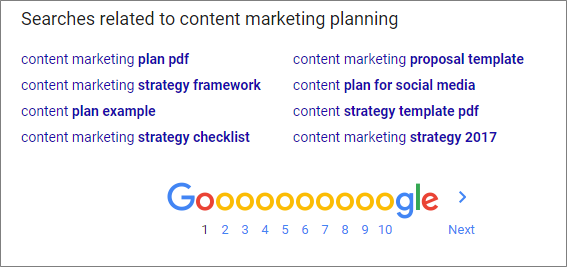When it comes to crafting compelling content that informs, engages and inspires action, seasoned B2B digital and content marketers know our content needs to captivate both humans and search engines to be effective. After all, 81% of B2B decision makers conduct research before reaching out to a vendor, so we know our content needs to meet them whenever and wherever they’re searching.
As a result, striking that “perfect balance” between SEO and user experience is a must—and that perfect balance is rooted in the content planning stage.
“SEO needs to be baked into the process early so that the optimization is as natural as possible,” Kevin Cotch, TopRank Marketing SEO analyst, says. “It can’t be treated as an afterthought. It’s not only more efficient to do your research up front, but it also enhances the content by helping you touch on the specific phrases your audience is using to search to solve their pain points or answer their questions.”
But there’s a little hitch—SEO research can be overwhelming for content creators. We’re often strapped for time and it’s easy to fall down a less-than-productive SEO rabbit hole. In addition, some of us may feel we don’t have the needed expertise or tools.
The good news is that you don’t need to fanciest tools or a dedicated background in SEO to craft great SEO-driven content. Below are a handful of helpful research tactics you can use to make the most of your time and create a content plan that’s flush with solid topics.
#1 – Perform incognito searches for your most important keywords.
Your team has likely developed a list of core keywords and topics that are incredibly important to your brand from a service and search standpoint. And you’ve likely begun to create content around those key topical areas and you’re seeing some movement in the SERPs. Naturally, your ultimate goal is to get your content to the top of Page 1 search results. But have you taken the time to dig in and draw insights from the content you’re hoping to dethrone?
Incognito searches using your priority keywords can help you uncover some of those important insights. An incognito search prevents your browser history or cache from impacting the results, allowing for a more accurate picture of search results. As my colleague Jesse Pickrain so eloquently said in one of my recent posts on finding B2B content marketing inspiration: “There’s gold in them thar SERPs.”
Once you’re served up with some results, spend about 10 to 15 minutes reviewing the content in the top three to five spots. Your goal should be to learn how the content is structured, identify the perceived value it provides your audience, the main pain points it addresses, and ultimately if you have the ability to create something better than what’s ranking at the top. In addition, take a peek at the “related searches” area so you can see other queries that match the search intent of your original search for more clarity and direction for planning your content.
Let’s take the keyword topic “content marketing planning” as an example. At first glance, I see the top results all offer frameworks or tactical guides.
As I dig in, I can see that four of the top five are all in-depth, long-form pieces, and the content is organized using a range of heading tags and bulleted sections to make it easy to scan. But I also notice that “content marketing planning” isn’t an exact keyword match, rather “content marketing strategy” is present in nearly all of the pieces.
In addition, I can see that the related searches have several variations of “content marketing strategy.” After clicking around in those results, I can see that a lot of the same content is coming up in the top five, but there’s a broader mix as the queries get more specific.
Roughly 10 minutes later, I’ve pulled some very valuable insights:
- Long-form content wins for this topic and search intent, and people are looking for detailed plans, examples and templates to make their lives easier.
- More people are searching for strategy-related keywords, which tells me that “content marketing strategy” may be more relevant or have higher volume, but it’s likely a more competitive keyword term.
- It’s going to be difficult to crack the top spots for short-tail keywords, but longer-tail or more specific, related search queries definitely have some opportunity.
Based on these insights, as well as my knowledge of existing content, I can start to flush out some relevant concepts that are on-topic and SEO-infused, and guided by the top-performing content that’s already out there. My goal now is to craft a concept that will provide a better answer than what currently exists.
#2 – Consult Google AdWords’ Keyword Planner tool for low-hanging opportunities or additional insight.
The Keyword Planner tool within Google AdWords is often a go-to research tool for SEO and developing paid search campaigns, providing cost-per-click data and average search volume estimates to help you judge competitiveness and relevancy.
When it comes to content planning, this data along with keyword topic and query suggestions, can help you identify low-hanging opportunities or further refine the other research you’ve already done.
Building off my previous example of “content marketing planning,” I know that my incognito search revealed that “content marketing strategy” was a heavily-related keyword from a search intent standpoint. I can now use the keyword planner to dive deeper into the competitiveness surrounding both variations, as well as related keywords, to further refine my concepts.
#3- Review Google Search Console to see what keywords your existing content is already ranking for.
In my opinion, Google Search Console, formerly Google Webmaster Tools, is one of the most helpful SEO and content planning tools out there. From a technical standpoint, Google Search Console enables you to monitor and maintain your entire website’s presence in Google search results. But from a content planning perspective, Google Search Console allows you to see which queries actually caused your site’s content to appear in search results.
The best part? You can filter by page, allowing you to see how a specific piece of content is drawing visibility. This means you can not only find opportunities to optimize existing content with other related keywords it’s coming up for, but also identify gaps and related topics that can spawn additional content.
#4 – Look to evergreen content for inspiration.
Chances are you have some really solid, evergreen pieces of content that are driving in huge amounts traffic. Why? Because that content is doing a great job at providing the answers searchers seek—and you can build off that.
Use the Google Search Console tip to understand which queries are getting eyeballs on that content, and be on the lookout for:
- Contextual nuances. Does it appear that your content isn’t the best answer for certain queries? If so, this is a golden opportunity to create new content that can better answer that query.
- Content branches. You may find that some of the queries your content is coming up for centers on a specific section of your content. If so, that may be an opportunity to drill-in deeper on that specific topic.
- Follow up questions. When you’re able to see the wide range of queries your existing content is coming up for, you can get a bigger picture of what questions your audience may ask next. If you identify next questions, you can create best-answer content and add add a call to action to that evergreen piece so readers can continue their journey.
#5 – Leverage free tools and Q&A platforms to uncover burning questions.
At TopRank Marketing, we believe that striving to be the best answer wherever and whenever your audience is searching is the key to creating content that resonates. Luckily, there are a number of free platforms and tools such as Quora, Answer the Public, Ubersuggest, and Keyword Tool.io that can provide quick answers and long-tail search opportunities.
Once you’ve discovered some of those burning questions, you can use the incognito search tip to understand what content already exists out there for that question, and determine how you can answer the question better and provide more value to searchers.
#6 – Use social media to get keywords and content topics directly from your audience.
Social media is all about giving people a place to share their thoughts and experiences with one another. So why not take advantage of your community’s willingness to share by asking engaging and thoughtful questions to tap into their insights?
A great example of this in action are Twitter polls, which allow people to weigh in on a specific topics as well as continue the conversation through the reply function. And, while they’re not exactly scientific, polls and social discussions can actually be a chunk of your content as you can feature the responses you get in the content to add more authenticity and perspective.
Don’t Fail to Plan
As the old adage goes: If you fail to plan, you plan to fail. And when it comes to crafting effective content, SEO needs to be part of the content marketing planning process if you want to drive results. Use these tips to help make it an easy and efficient part of the process.
What are some interesting ways you conduct SEO research for your B2B brand? Tell us in the comments section.
Gain a competitive advantage by subscribing to the
TopRank® Online Marketing Newsletter.
© Online Marketing Blog - TopRank®, 2017. | 6 Quick & Dirty SEO Research Tips for B2B Content Planning | http://www.toprankblog.com
The post 6 Quick & Dirty SEO Research Tips for B2B Content Planning appeared first on Online Marketing Blog - TopRank®.




No comments:
Post a Comment